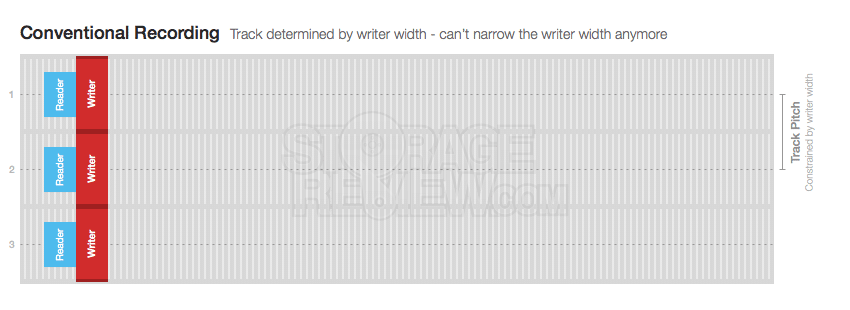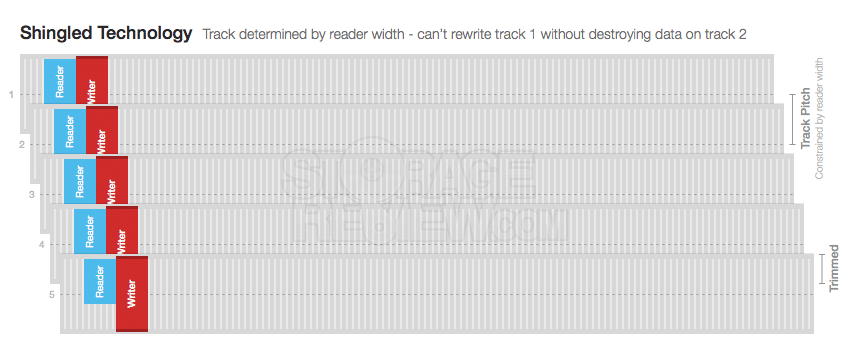In the simplest terms, Shingled Magnetic Recording (SMR) is a new hard drive technology that allows the tracks on a platter to be layered on top of each other, just like roof shingles on a house, to increase platter density or tracks per inch (TPI). Current technology, Perpendicular Magnetic Recording (PMR), uses a parallel track layout. By increasing TPI with SMR technology and decreasing the space between tracks, SMR offers tremendous potential for overall hard drive capacity gains. The end product physically looks and feels like a standard PMR drive, with higher capacity in the same physical footprint. However, the architecture change means the user experience from a performance perspective will be dramatically different.
The Problem with PMR Scalability
Engineers are running into difficulty scaling drive capacity using PMR due to physical limitations inherent in the current recording process. As areal density is increased on a drive platter, the size of a bit on the media is decreased. To maintain sufficient signal-to-noise ratio (SNR) to read, manufacturers must decrease the grain size on the media. That in turn causes the energy barrier for flipping the bit to decrease since the volume of the material holding the bit decreases. A low energy barrier means that ambient thermal energy is more likely to flip the bit, reducing data integrity.
In order to strengthen the energy barrier, coercivity of the material must be increased to mitigate the risk of flipped magnetization. This is an issue however as manufacturers try to reduce the size of the write head to enable more tracks on a platter. A smaller write head means a smaller write field and the industry is at the point where the smaller write field is becoming insufficient to change the magnetization on the media, preventing the write from occurring.
The Impact of SMR
SMR addresses this problem by not scaling the writer down, in fact, the writer head is intentionally larger in an SMR drive. The larger writer means it can more effectively magnetize (write) the media without having to compromise readability or stability (retention).
A visualization of how PMR and SMR differ is helpful in understanding both the challenges and benefits of SMR technology. As noted, PMR tracks are laid out in parallel around the surface of the media as seen below.

With SMR, it’s easy to see where the writer width isn’t a problem, and how a more narrow read head can benefit capacity over time so that capacity gains are only limited by the ability to shrink the reader and grain sizes.

Challenges with SMR
Clearly with the SMR layout, a new problem is introduced. The write head is wider than a single track, meaning when data is written to an SMR hard drive, data must be written sequentially so the writer doesn’t destroy data on the overlapping tracks.
Of course many operating and file systems aren’t used to being restricted to writing sequentially to hard disk drives. As a result, a management or translation layer needs to be created to take random writes and convert them to sequential writes.
Where this layer resides and how it manages metadata is a new issue that will be discussed in detail by examining methodologies of SMR data management. These include three core methods; Drive Managed, Host Aware and Host Managed.
Our reviews of SMR products:




 Amazon
Amazon